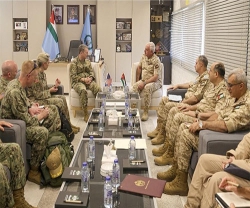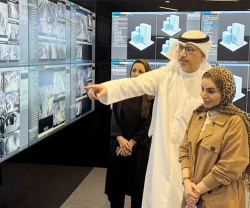Gulf: Nucleus of Middle East Defense Growth
28.01.2010 MENA
Sustained by the spending habits of the Gulf nations, the Middle East represents one of the world's most robust defense markets and should remain that way in the near future.
The six countries (Bahrain, Kuwait, Oman, Qatar, Saudi Arabia, and the United Arab Emirates) that make up the Gulf Cooperation Council (GCC) will account for roughly 60 percent of all defense expenditures made in the region in 2010, according to a recent Middle East military market analysis by Forecast International. In 2010, these countries are projected to invest over $63 billion toward their armed forces and security, with two-thirds of that total contributed by Saudi Arabia alone.
FI expects that this trend will continue. Combined GCC defense spending is expected to rise in 2011 by an additional 2.5 percent. Over the next five years, the greater Middle East defense market is projected to grow by over 11 percent, reaching nearly $120 billion by 2014.
The seemingly unstoppable defense-spending binge by the Middle East and the GCC members has been fueled by their quest to close the strategic gap between themselves and regional rival Iran by acquiring superior military hardware and technologies.
Though concerns over Iran's nuclear program and aggressive posture are the major motivating factors behind the defense-spending habits of the GCC, internal security remains a priority for the Gulf kingdoms, evinced foremost by Saudi Arabia's multi-billion dollar Saudi Border Guard Development Program (SBGDP).
Because of the continued strength of the greater Middle East, suppliers are looking to lock down their own corners of the market. The United Kingdom is the second-largest arms provider to the region, followed closely by Russia, which has carved out a niche for itself from countries sidelined by Western suppliers. Russia's clientele includes Iran, Syria, and Yemen. Furthermore, Moscow is hoping to soon finalize a $2-$4 billion arms package with Saudi Arabia.
But the U.S. remains by far the biggest supplier to the region. From 2005 through 2008, the U.S. delivered more than half of the Middle East’s military hardware. Though the U.S. remains sensitive to the potential erosion of Israel's regional qualitative military edge, it has granted major equipment sales to Gulf nations in recent years, including advanced air defense systems and "bunker-buster" bombs to the UAE, AH-64D Apache Longbow attack helicopters to the Saudis, and F-16s and Harpoon and Hellfire missiles to Egypt.
The six countries (Bahrain, Kuwait, Oman, Qatar, Saudi Arabia, and the United Arab Emirates) that make up the Gulf Cooperation Council (GCC) will account for roughly 60 percent of all defense expenditures made in the region in 2010, according to a recent Middle East military market analysis by Forecast International. In 2010, these countries are projected to invest over $63 billion toward their armed forces and security, with two-thirds of that total contributed by Saudi Arabia alone.
FI expects that this trend will continue. Combined GCC defense spending is expected to rise in 2011 by an additional 2.5 percent. Over the next five years, the greater Middle East defense market is projected to grow by over 11 percent, reaching nearly $120 billion by 2014.
The seemingly unstoppable defense-spending binge by the Middle East and the GCC members has been fueled by their quest to close the strategic gap between themselves and regional rival Iran by acquiring superior military hardware and technologies.
Though concerns over Iran's nuclear program and aggressive posture are the major motivating factors behind the defense-spending habits of the GCC, internal security remains a priority for the Gulf kingdoms, evinced foremost by Saudi Arabia's multi-billion dollar Saudi Border Guard Development Program (SBGDP).
Because of the continued strength of the greater Middle East, suppliers are looking to lock down their own corners of the market. The United Kingdom is the second-largest arms provider to the region, followed closely by Russia, which has carved out a niche for itself from countries sidelined by Western suppliers. Russia's clientele includes Iran, Syria, and Yemen. Furthermore, Moscow is hoping to soon finalize a $2-$4 billion arms package with Saudi Arabia.
But the U.S. remains by far the biggest supplier to the region. From 2005 through 2008, the U.S. delivered more than half of the Middle East’s military hardware. Though the U.S. remains sensitive to the potential erosion of Israel's regional qualitative military edge, it has granted major equipment sales to Gulf nations in recent years, including advanced air defense systems and "bunker-buster" bombs to the UAE, AH-64D Apache Longbow attack helicopters to the Saudis, and F-16s and Harpoon and Hellfire missiles to Egypt.
Latest news
Latest events
DefenPol China2025 - 7th Guangzhou International Defense & Police Exhibition & Summit
11 - 12 Jul 2025Nan Fung International Convention & Exhibition Center (NICEC) - ChinaIDEF 2025 Turkey - International Defence Industry Fair
22 - 27 Jul 2025Istanbul Expo Center - TurkeyDSEI 2025
09 - 12 Sep 2025Excel, London - United KingdomIntersec Saudi Arabia
29 Sep - 01 Oct 2025Riyadh International Exhibition & Convention Centre - Saudi Arabia






















